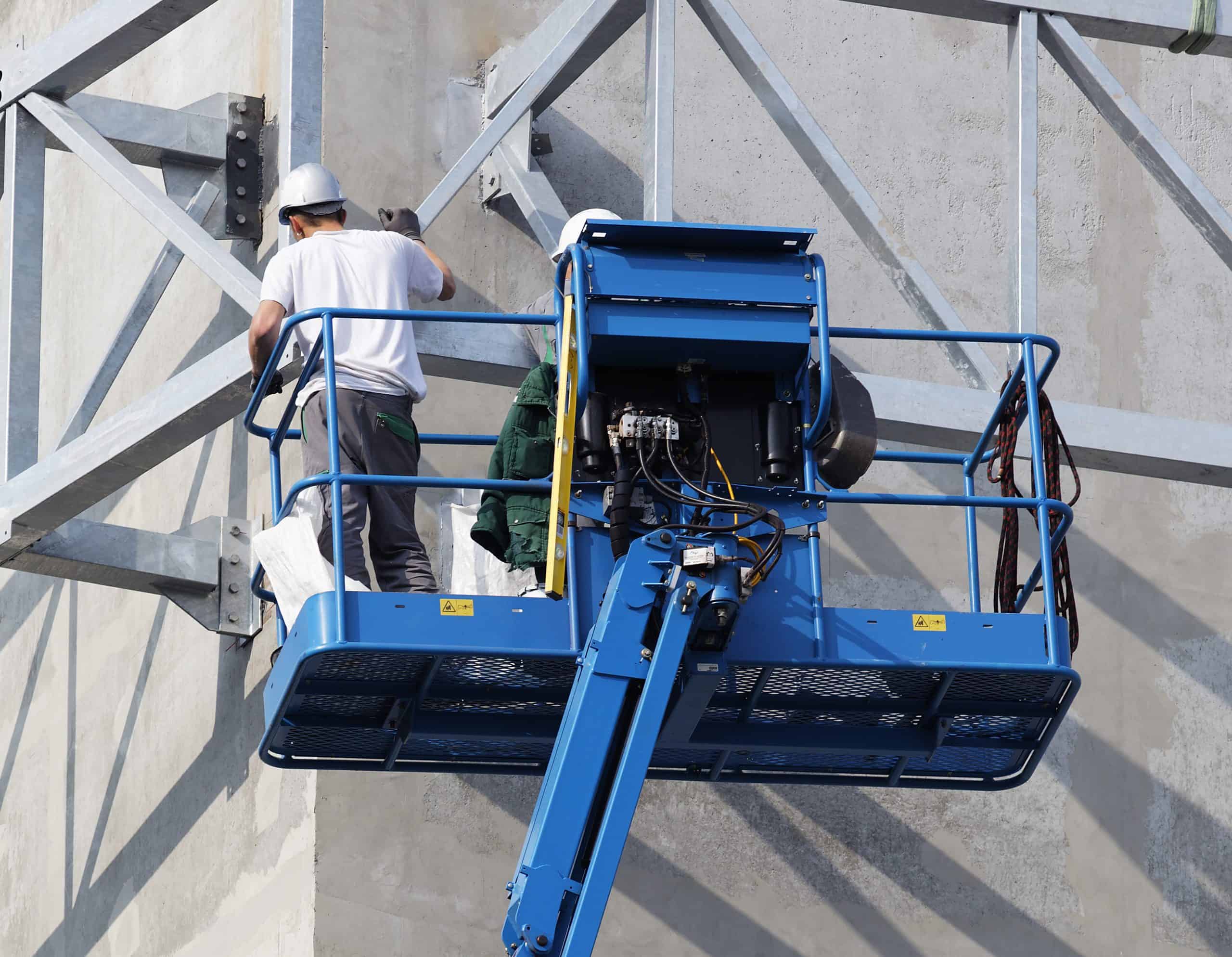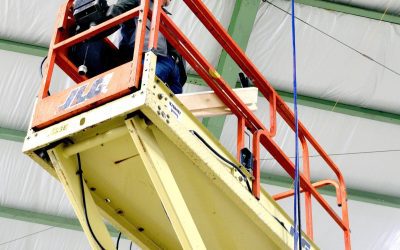Aerial Lift Rental Safety Guide: Most Common Accidents, and What You’re Responsible For
Renting an Aerial Lift? Here’s What You Need to Know About Safety, Accidents, and OSHA Compliance
If you’re renting an aerial lift for your next job—whether it’s a scissor lift, boom lift, or vertical mast—you’re responsible for more than just pickup and return. You’re responsible for safety.
Falls, tip-overs, and electrocutions are some of the most common—and preventable—incidents involving aerial lifts. And when something goes wrong, it’s not just an operator at risk—it’s your crew, your jobsite, and your business on the line.
This guide covers:
- The most common aerial lift accidents
- What rental customers need to know about safe operation
- OSHA training requirements
- Pre-use inspections
- How to avoid fines and downtime
Most Common Aerial Lift Accidents on Rental Jobsites
Here are the top accident types and what usually causes them:
| Accident Type | What Causes It | What Can Happen |
|---|---|---|
| Falls from height | No harness, guardrail bypass, platform exit | Serious or fatal injuries |
| Tip-overs | Soft ground, uneven terrain, driving while raised | Equipment damage, crushed operators |
| Electrocution | Contact with power lines, lack of site planning | Fatal shocks, burns, jobsite shutdowns |
| Crushing/Struck-by | Tight clearance, boom swing, poor visibility | Head trauma, amputations |
| Equipment failure | Skipped inspections, lack of operator checks | Drop accidents, hydraulic failure |
Why Rental Customers Need to Take Safety Seriously
When you rent an aerial lift, you’re also accepting the responsibility to:
- Ensure only trained operators use it
- Complete pre-use inspections daily
- Keep the machine on safe, stable ground
- Follow manufacturer instructions and OSHA rules
- Use proper fall protection (especially in boom lifts)
Failure to do these things can lead to OSHA fines, project delays, and serious injuries.
OSHA Training Requirements for Rented Aerial Lifts
Renting a lift doesn’t remove your duty to train your operators.
Under OSHA 29 CFR 1926.453 and 1910.67, aerial lift operators must be trained on:
- How to safely operate the specific lift type (scissor, boom, etc.)
- Hazards like falls, tip-overs, and overhead contact
- How to inspect the lift and respond to emergencies
Hands-on training and evaluation are required, and retraining is needed if:
- The worker uses a new type of lift
- There’s an accident or near miss
- Unsafe use is observed
Rental companies are not responsible for your training. That’s on you.
Pre-Use Inspections: Your First Line of Defense
Before each shift or job use, operators must inspect:
- Tires, wheels, and outriggers for damage
- Hydraulics and hoses for leaks
- Guardrails, gates, and platform floor
- Tilt alarms and emergency stops
- Harnesses and anchor points (for boom lifts)
If anything is wrong, tag it out and contact the rental company immediately. Don’t try to use a damaged lift.
Common Mistakes Rental Customers Make (and How to Avoid Them)
-
Using the wrong lift for the job
→ Know your height, weight, and terrain needs before renting. -
Skipping harnesses in boom lifts
→ Fall protection is required. Always wear a full-body harness and lanyard. -
Working near power lines without clearance
→ Stay at least 10 feet away from any overhead electrical source. -
Driving the lift while elevated
→ Most scissor lifts aren’t rated for elevated travel. Know your machine’s limits. -
Letting untrained workers operate the lift
→ This is an OSHA violation—and a legal liability if something goes wrong.
Liability and Cost: What Happens When Accidents Involve Rentals
If a rented aerial lift is involved in an accident and the operator wasn’t trained or safety protocols weren’t followed, the rental customer may face:
- OSHA citations and fines (up to $15,000 per violation)
- Workers’ compensation claims
- Equipment damage fees
- Delays or shutdowns on site
- Legal liability for injuries or deaths
Rental companies typically disclaim responsibility in their contracts for improper use or lack of training. Your insurance may not cover the incident if safety rules were ignored.
Smart Rental Safety Tips
- Know what type of lift you need—don’t guess
- Ask your rental rep for the operator manual and inspection checklist
- Ensure your workers are trained and certified
- Have a rescue plan in place for elevated work
- Follow all manufacturer guidelines
- Keep daily inspection records for OSHA compliance
Frequently Asked Questions (FAQ) for Aerial Lift Rental Customers
1. Do rental companies provide operator training?
No. Most rental companies do not provide OSHA-compliant operator training by default. As the rental customer, you are responsible for making sure your workers are trained and certified before operating any aerial lift. OSHA requires this under 29 CFR 1926.453 and 1910.67.
2. Can anyone on my crew operate a rented aerial lift?
Only if they’ve been properly trained and evaluated on that specific type of lift (e.g., boom, scissor, vertical mast). Untrained operation is a serious OSHA violation and can expose your company to fines and legal liability.
3. Am I responsible for daily inspections during the rental period?
Yes. Aerial lift operators must do a pre-use inspection at the beginning of every shift. This includes checking the tires, controls, hydraulics, safety systems, and platform condition. If anything seems off, the lift should be tagged out and reported immediately.
4. What if the rented lift breaks down or has a safety issue?
Stop using it immediately. Contact the rental company to report the issue. Do not attempt repairs unless you’re authorized and trained. Most rental contracts require you to report defects quickly and avoid further use until inspected.
5. Do I need to provide fall protection for workers using a rented boom lift?
Yes. OSHA requires operators in boom lifts to wear a full-body harness with a lanyard connected to an anchor point in the platform. For scissor lifts, fall protection is usually not required if the guardrails are in place and secure.
6. Can I use a boom or scissor lift near power lines?
Only if you maintain the minimum safe distance. OSHA requires at least 10 feet of clearance from energized power lines under 50kV. Higher voltages require more distance. Contact with power lines is one of the leading causes of aerial lift fatalities.
7. Can I drive the lift while it’s raised?
Only some scissor lifts and boom lifts are rated for elevated travel. If your lift isn’t designed for that, driving while raised can cause a tip-over. Check the operator manual or ask the rental company before moving the lift in the air.
8. What paperwork should I keep during a lift rental?
You should maintain:
- Training records for all operators
- Daily inspection checklists
- The operator manual provided by the rental company
- Any service or repair reports if issues occur
Keeping documentation helps you stay OSHA-compliant and proves your due diligence if an incident happens.
9. Who’s responsible if there’s an accident with a rented lift?
In most cases, you are. Rental agreements typically state that the customer is responsible for safe use, operator training, and compliance with all regulations. If safety rules were not followed, OSHA fines, lawsuits, and insurance claims could fall on you or your company.
10. How can I reduce risk when renting aerial lifts?
- Rent the right lift for the job
- Make sure all operators are trained
- Use fall protection where required
- Keep daily inspection logs
- Respect ground conditions, wind limits, and load ratings
- Stay clear of power lines
- Call your rental rep with any questions or concerns

